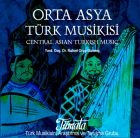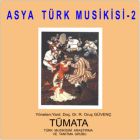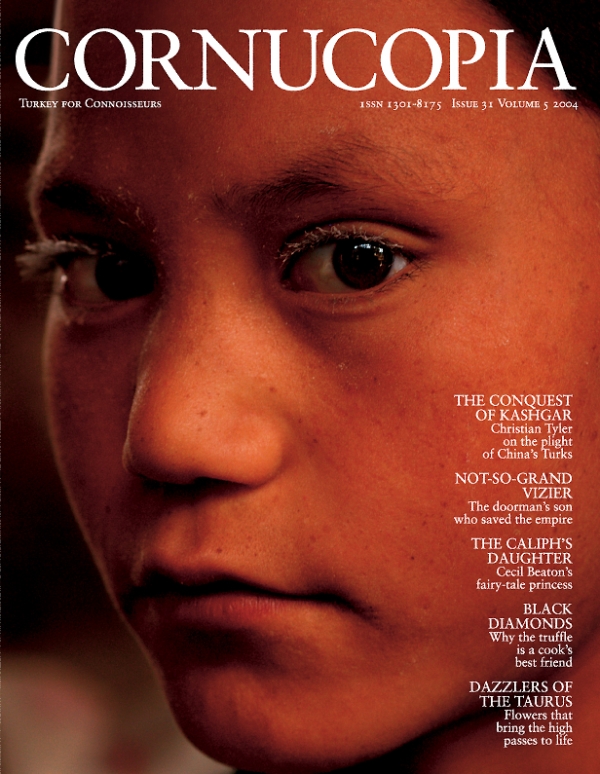Buy or gift a stand-alone digital subscription and get unlimited access to dozens of back issues for just £18.99 / $18.99 a year.
Please register at www.exacteditions.com/digital/cornucopia with your subscriber account number or contact subscriptions@cornucopia.net
Buy a digital subscription Go to the Digital EditionThe Kirghiz are a semi-nomadic Turki-speaking people from the old Turkistan borderlands of China, old Russia and Afghanistan. Stalin, in a spirit of divide et impera, drew the borders of Kyrgyzstan, as he did with the other Soviet Central Asian republics, right across the ethnic divides, scattering the Kirghiz between Kyrgyzstan, Tajikistan and Kazakhstan.
The Kirghiz do not migrate great distances. In the summer they take their flocks and wooden-framed felt yurts (boz ooy up to the high mountain pastures of the Pamirs or the Tien Shan. When the approaching winter snows drive them down, they spend the winter in their solid stone-built houses, usually not more than thirty miles or so from the summer grazing grounds.
A much longer migration was made by a small group of Kirghiz from the Lesser Pamir in modern Tajikistan. In the 1920s the Bolsheviks started picking off the Kirghiz khans one by one. When they captured the last of them, Hajji Jabbar Kul Khan, they gave him and his son the choice of death by bullet or by poison. The two took poison and the Russians left them to die. Jabbar Kul Khan and his son crawled to a nearby house, where they were given bowls of kurut (dried yoghurt) mixed with water. They drank long draughts of it and managed to recover.
The two men had no wish to see their flocks collectivised, and they led their tribe, about 1,500-strong, to refuge in China among the Uighurs of Eastern Turkistan (Xinjiang). In 1933 the Russians invaded Chinese Turkistan, at the invitation of the Chinese, to put down a Basmachi revolt. The tribe went back to the Pamirs. More Russian attacks followed. In 1942 Jabbar Kul Khan died. His son Rahman Kul took his tribe to refuge once more in Chinese Turkistan, where they stayed until the arrival of the Communists in 1949. Again they had to move, this time to the Wakhan, the one place that was safe from Communists.
The Wakhan is the panhandle of Afghanistan high up in the Pamirs that formed a barrier between Russia, India and China. In 1891 the British had forced Amir Abdul Rahman of Afghanistan to take responsibility for the Wakhan, which had previously been an unmapped no-man’s-land. He had no desire to take charge of such a remote place, “full of bandits” as he said, but the English required him to provide a neutral buffer between Russia and India.
Although safe from Stalin to the north and Mao to the south, the Wakhan was not an ideal refuge. It is all high summer pasture, far too cold for the winter, far from cultivation and civilisation and with little to feed livestock on. The sheltered winter grounds were inaccessible, low down beyond the borders on either side. In winter the Kirghiz shivered hungrily in their boz ooys. In the early 1970s André Singer made a very good documentary about Rahman Kul and his tribe in Afghanistan.
In 1978 the Kirghiz of the Wakhan were alarmed by the arrival of Russian surveyors. Not waiting to be dispossessed once more, Rahman Kul led his people and their flocks down into Gilgit in Pakistan, where they had trading connections. About 300 of them died on the way. Shortly afterwards the Russians invaded Afghanistan, treating the remaining Kirghiz remarkably well. Although Rahman Kul’s men were safe in Gilgit, the climate was too hot and unhealthy for these mountain people, and there was no grazing for their sheep. Rahman Kul had to sell most of them, keeping charge of the money himself.
With no means of livelihood left to them, the Kirghiz needed somewhere more suitable to live. An idea was briefly mooted by a UN wildlife conservationist that Alaska might be suitable, but it came to nothing. In 1982 Rahman Kul negotiated with the presidents Zia ul-Haq of Pakistan and Kenan Evren of Turkey, who arranged an airlift for the Kirghiz and the remainder of their flocks to Turkey. They were flown in military transports to Adana and from there were taken to the earthquake relief village of Karagündüz near Van, where they were allotted nearby grazing grounds.
This was not an ideal solution. The very basic earthquake shelters were empty because the local villagers found them suitable only for storage or sheep sheds. The grazing grounds allotted to the new arrivals by the local authorities were the traditional pastures of the local Kurds, who did not feel disposed to welcome the new arrivals. In 1987 the Özal government arranged for the 300 Kirghiz families to be moved to Zilandere near Erciş, where the new village of Ulu Pamir was built for them. Rahman Kul Khan spent the last four years of his life in Ulu Pamir and died there aged seventy-seven. It is remarkable how easy the Turki spoken by the Kirghiz was for Turkish speakers to follow, unlike Kazakh or Uzbek.
The 200-odd Kirghiz families who remained in Afghanistan are in a sorry state. They are illiterate, and they and their khans are given to smoking opium grown in Badakhshan. They are prevented by the Russian border guards in Tajikistan from crossing the Oxus border to visit their kinsmen to trade. The Little Pamir Kirghiz in Tajikistan are better off and able to trade with Gilgit in Pakistan and Tash Kurgan in Xinjiang. Two Kirghiz mullahs came back from Turkey to encourage them in the faith, but they quickly succumbed to the charms of the opium pipe.
The Kirghiz herdsmen who remained under Soviet rule did not do badly. Once the Russians had got rid of their khans, they provided them with education and healthcare. The Kirghiz even fought loyally for Russia in the Panfilovski Brigade at Stalingrad. Unless the Americans have just had them pulled down, the statues of Lenin, Panfilov and General Frunze, who won Turkistan back for the Russians after the Bolshevik Revolution, still stand in the Kyrgyzstan capital of Bishkek.
After years of wandering in western China, Afghanistan and Pakistan, a group of Kirghiz have finally made a lasting home in the highlands of eastern Anatolia. The historian Hasan Ali Karasar, who as a boy in Van witnessed their arrival, recounts their extraordinary tale. Photographs by Jonathan Henderson
The most wondrous tiled dome, the biggest and best-ever food bazaar, the most handsome man in the world… Uzbekistan, as Min Hogg discovers, inspires a profusion of superlatives, even if she tangles with the transport. In Samarkand, Tamerlane’s fabled capital, she finds herself lost for words. Photographs by Min Hogg
After years of delving deep into the origins of writing and language Kâzım Mirşan has put forward an astonishing claim: that at the root of it all is an ancient, proto-Turkish mother tongue. Genius or dreamer? Christian Tyler meets a man whose hypotheses threaten to turn the very history of man on its head.
A special report on the Royal Academy’s amazing ‘Turks’ exhibition
Kate Clow, creator of Turkey’s first official walking route, has done it again. Caroline Finkel joined her on the new St Paul Trail, which crosses southern Turkey’s giant Taurus range. The photographs in this stunning 14-page article are by Kate Clow with Terry Richardson
The börek has an extensive place in Turkey’s culinary repertoire, and the choice of fillings is infinite. From cheese to spicy ground meat or suateéd meat cubes with nuts and raisins; from chicken or turkey to fish and lentils; from offal such as brain or tripe to vegetables – the list is almost endless.
More cookery features
Brave new wines from Turkey. Kevin Gould on the independent spirit of Turkish wine makers. Photograph by Berrin Torolsan
Old favourites and new attractions: Andrew Finkel samples Istanbul’s best meyhanes. Photographs by Simon Wheeler

TÜMATA The Traditional Turkish Music Research and Promotion Society, Dr Rahmi Oruç Güvenç

TÜMATA The Traditional Turkish Music Research and Promotion Society, Dr Rahmi Oruç Güvenç


Cornucopia works in partnership with the digital publishing platform Exact Editions to offer individual and institutional subscribers unlimited access to a searchable archive of fascinating back issues and every newly published issue. The digital edition of Cornucopia is available cross-platform on web, iOS and Android and offers a comprehensive search function, allowing the title’s cultural content to be delved into at the touch of a button.
Digital Subscription: £18.99 / $18.99 (1 year)
Subscribe now